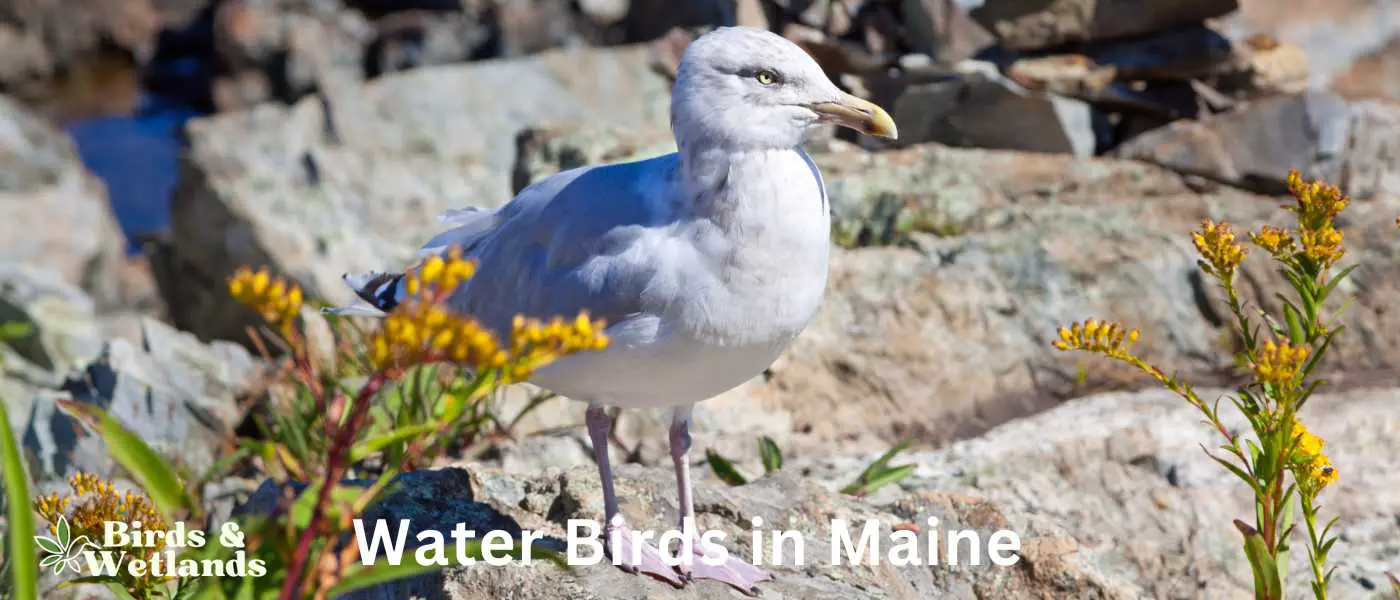Situated at the northeastern tip of the United States, Maine is a splendid refuge for a diverse assortment of water birds. With its rugged coastline, myriad of lakes, and extensive wetlands, Maine offers a variety of habitats that cater to these fascinating creatures.
Maine water birds
| Water Bird Species | Frequency in Maine | Where to Find in Maine |
|---|---|---|
| American White Pelican | Uncommon | Rare sightings on large inland lakes |
| Double-Crested Cormorant | Common | Coastal areas, Penobscot Bay |
| Great Blue Heron | Common | Wetlands, rivers, and lakes statewide |
| Great Egret | Uncommon | Southern coastal areas, Scarborough Marsh |
| Snowy Egret | Uncommon | Southern coastal areas, Scarborough Marsh |
| Green Heron | Common | Wetlands and ponds statewide |
| Black-Crowned Night-Heron | Uncommon | Coastal wetlands, Portland Harbor |
| Mallard | Very Common | Lakes, ponds, and rivers statewide |
| Wood Duck | Common | Wetlands and ponds statewide |
| Blue-Winged Teal | Common | Wetlands, especially in the south |
| Northern Pintail | Uncommon | Coastal areas in migration |
| American Black Duck | Very Common | Lakes, ponds, and coastal areas |
| Common Eider | Very Common | Coastal areas statewide |
| Bufflehead | Common | Coastal areas, large inland lakes |
| Hooded Merganser | Common | Freshwater bodies statewide |
| Common Merganser | Common | Rivers and large lakes statewide |
| American Coot | Uncommon | Occasional on larger lakes and coastal areas |
| Sandhill Crane | Uncommon | Open fields and marshes, Aroostook County |
| American Wigeon | Uncommon | Wetlands, large bodies of water |
| Osprey | Common | Near water bodies statewide |
| Red-breasted Merganser | Common | Coastal areas statewide |
| Common Loon | Very Common | Lakes, ponds, and coastal areas |
| Atlantic Puffin | Uncommon | Coastal islands, Machias Seal Island |
| Least Bittern | Uncommon | Freshwater marshes, Scarborough Marsh |
Water Bird Species Found in Maine
American White Pelican


| Feature | Measurement |
|---|---|
| Scientific Name | Pelecanus erythrorhynchos |
| Length | 50–70 in |
| Wingspan | 95–120 in |
| Weight | 3.5 and 13.6 kg |
The American White Pelican (Pelecanus erythrorhynchos) is one of North America’s largest birds, distinguished by its brilliant white plumage, elongated orange bill, and massive wingspan, which can extend up to 3 meters. This bird has a unique appearance with its distinctive pouch used for feeding and a “horn” on the upper part of the bill during the breeding season. Though a large bird, it is very graceful in flight, often seen soaring in flocks in a V formation.
American White Pelicans inhabit lakes, marshes, and salt bays, and despite their size, they are excellent swimmers. They feed primarily on fish, using a cooperative hunting strategy where they encircle schools of fish in shallow water and then scoop them up in their bill pouches. Unlike their brown pelican relatives, they do not dive for their food. During the breeding season, these pelicans will nest in colonies on islands in freshwater lakes.
Double-crested cormorant


| Feature | Measurement |
|---|---|
| Scientific Name | Nannopterum auritum |
| Length | 28–35 in |
| Wingspan | 45–48 in |
| Weight | 1.2–2.5 kg |
The Double-Crested Cormorant (Phalacrocorax auritus) is a large waterbird known for its long neck, hooked bill, and almost entirely black body. The species gets its name from the two small patches of tufted feathers or “crests” found on the heads of breeding adults, one on each side. These birds are strong swimmers that propel themselves underwater with their webbed feet, their bodies submerged and necks above the water surface, giving them a characteristic snake-like appearance when swimming.
Double-Crested Cormorants are widely distributed across North America and can be found in a variety of aquatic environments including freshwater lakes, coastal areas, and rivers. Their diet primarily consists of fish, which they catch by diving from the water’s surface. Often seen perched with wings outstretched to dry after fishing, these cormorants nest in trees, on the ground, or on cliff edges, usually in colonies. While they have rebounded from decreases in the mid-20th century due to DDT-related reproductive failures, they face ongoing threats from habitat loss, entanglement in fishing gear, and conflicts with fisheries over their consumption of fish. Protection and careful management of their habitats are key to their ongoing conservation.
Great Blue Heron


| Feature | Measurement |
|---|---|
| Scientific Name | Ardea herodias |
| Length | 36–54 in |
| Wingspan | 66–79 in |
| Weight | 1.82–3.6 kgs |
Great Blue Herons are the largest heron species in North America, is distinguished by its tall stature and unique blue-gray plumage.
Measuring up to 4.5 feet tall with a wingspan of approximately 6.5 feet, the bird features a long, pointed bill, a white head with a black eye stripe extending to slender black plumes, and robust, elongated legs. Its distinctive flight pattern, forming a tight “S” shape with its neck, sets it apart from similar large birds, like cranes.
Inhabiting various wetland habitats, including marshes, lakes, rivers, and coastal regions throughout much of North and Central America, the Great Blue Heron is a wading bird. Often seen poised statue-like at the water’s edge, these birds are expert hunters, spearing fish and capturing small animals with their sharp bills.
Great Egret


| Feature | Measurement |
|---|---|
| Scientific Name | Ardea alba |
| Length | 31 to 41 in |
| Wingspan | 52 to 67 in |
| Weight | 1.5 to 3.3 lbs |
The Great Egret (Ardea alba), also known as the Common Egret, is a large, elegant wading bird recognized for its brilliant white plumage, slender black legs, and long, dagger-like yellow bill.
With a height of up to 3.3 feet and a wingspan of 52 to 67 inches, this bird is amongst the largest of the heron species. Its stately appearance and serene comportment have made it a popular symbol in many cultures and an eye-catching sight in its habitats.
Found across all continents except Antarctica, the Great Egret resides in both fresh and saltwater wetlands, including marshes, ponds, and coastal areas. It feeds mainly on fish, but it also hunts amphibians, small mammals, and invertebrates.
Snowy Egret

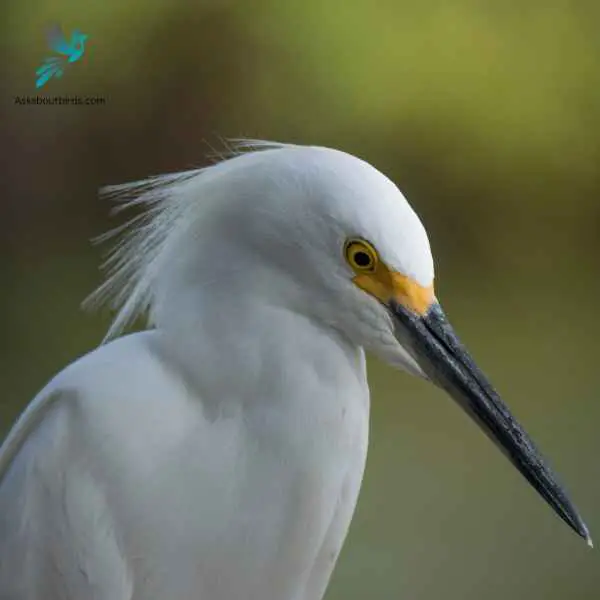
| Feature | Measurement |
|---|---|
| Scientific Name | Egretta thula |
| Length | 22.1–26.0 in |
| Wingspan | 39.4 in |
| Weight | 370 g |
The Snowy Egret (Egretta thula) is a small and active wading bird, celebrated for its delicate beauty. It sports an entirely white plumage that appears to glow against its black bill and legs, and striking yellow feet, which often play a crucial role in luring prey during feeding.
The Snowy Egret is further adorned with fine, plume-like feathers on its head, neck, and back during the breeding season, making it one of the more distinctive heron species.
Inhabiting wetland areas across the Americas, the Snowy Egret can be found in marshes, swamps, shorelines, and tidal flats where it feeds primarily on fish, but also consumes insects, crustaceans, and small reptiles.
Green Heron


| Feature | Measurement |
|---|---|
| Scientific Name | Butorides virescens |
| Length | 16-18 inches |
| Wingspan | 25-27 inches |
| Weight | 6-7 ounces |
The Green Heron is a small heron found in North America, notable for its deep green back and chestnut body, as well as its unique fishing tactics.
Appearance: Green Herons are dark and compact birds with a glossy, greenish-black cap, a greenish back and wings, and chestnut neck and belly. The bill is long, dark and sharply pointed. Their legs are bright orange or yellow. Young birds are duller in color, with a dark top and streaked brown front.
Diet: The Green Heron’s diet is quite varied, consisting mostly of small fish, but also includes insects, spiders, and sometimes amphibians and small mammals. It’s known for its tool-using behavior where it drops bait onto the water’s surface to attract fish.
Reproduction: Green Herons are solitary birds except during the breeding season, where they form monogamous pairs. Nests are typically built in trees or shrubs near water. Females lay 2 to 5 pale blue-green eggs that both parents incubate.
Black-Crowned Night-Heron
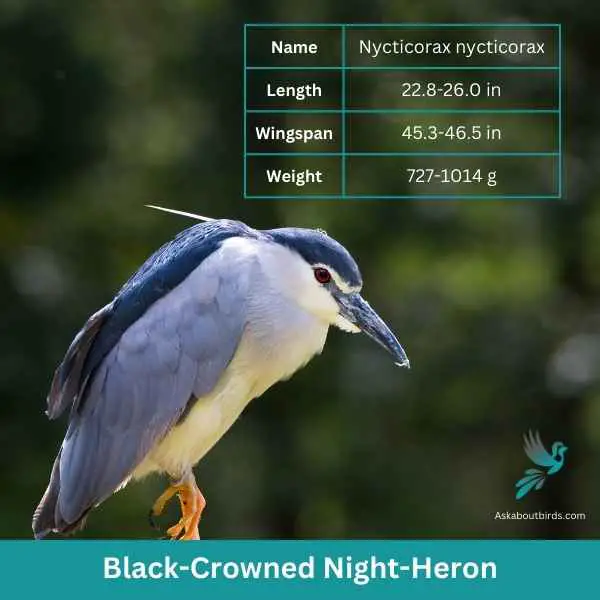

| Feature | Measurement |
|---|---|
| Scientific Name | Nycticorax nycticorax |
| Length | 22.8-26.0 in |
| Wingspan | 45.3-46.5 in |
| Weight | 727-1014 g |
The Black-Crowned Night-Heron (Nycticorax nycticorax) is a medium-sized heron species known for its distinct nocturnal habits and characteristic appearance. The bird displays a stocky silhouette, with a black crown and back, contrasting starkly with its light grey wings and white underparts.
Its eyes are large and red, adapted for its night-time activities, and its legs are relatively short for a heron. The bill is sturdy and black, and during the breeding season, two to three long white plumes extend from the back of the head.
Residing in a wide variety of wetland habitats, from freshwater marshes to coastal regions, the Black-Crowned Night-Heron is found across a large global range, including the Americas, Europe, Asia, and Africa. The species primarily feeds on fish and invertebrates, but it is known to be opportunistic and will also eat small mammals, birds, and eggs.
Mallard


| Feature | Measurement |
|---|---|
| Scientific Name | Anas platyrhynchos |
| Length | 20-26 inches |
| Wingspan | 32-39 inches |
| Weight | 1.6-3.5 pounds |
The Mallard, one of the most recognizable of all ducks, is distinguished by its classic “quack” and its common presence in city parks and wild wetlands.
Appearance: Mallards are large ducks with a hefty body and rounded head. The male is notable for its glossy green head, gray body, and black tail-curl, while the female is mottled brown with an orange-brown bill. Both sexes have a white-bordered, blue “speculum” patch in the wing.
Diet: Mallards are omnivorous, dabbling ducks that eat a wide variety of foods. They are known to feed on aquatic vegetation, insects, worms, and grains. In city parks, they are often seen eating bread, popcorn, and other food provided by humans, although such items are not part of their natural diet.
Reproduction: Mallards nest on the ground on dry land that is close to water, under cover of tall grass or other vegetation. The female typically lays around 8 to 13 eggs and incubates them herself.
Wood Duck

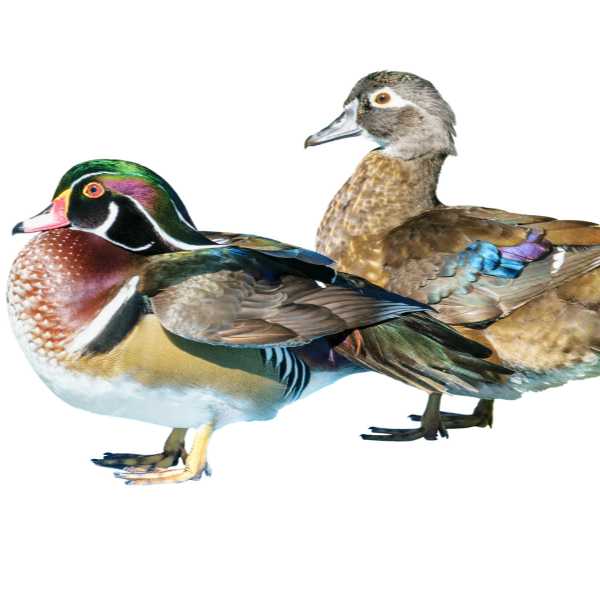
Listen:
Scientific Name: Aix sponsa
Length: 19 to 21 in
Wingspan: 26 to 29 in
Weight: 16.0-30.4 oz
The Wood Duck is an exquisitely colorful waterfowl known for its unique nesting habits and is commonly seen in wooded swamps, marshes, and streams across North America.
Appearance: With their dazzling plumage, Wood Ducks are among the most stunning birds. Males display a multitude of colors, including a green and purple crested head, red eyes, and a white-striped chest, all contrasted with a bronze-colored body. Females, though more subdued with a gray-brown body and white eye-ring, also possess their own charm.
Diet: Wood Ducks have a diverse diet that includes seeds, fruits, and insects, as well as other invertebrates. Their broad diet helps them to adapt to a variety of habitats, whether in the wild or in urban areas with suitable nesting sites.
Reproduction: Unlike most other ducks, Wood Ducks prefer to nest in tree cavities near water, leading to their common name. They will also readily use nest boxes if they’re available. A typical clutch consists of 9 to 14 eggs, which the female incubates alone.
Blue-winged Teal
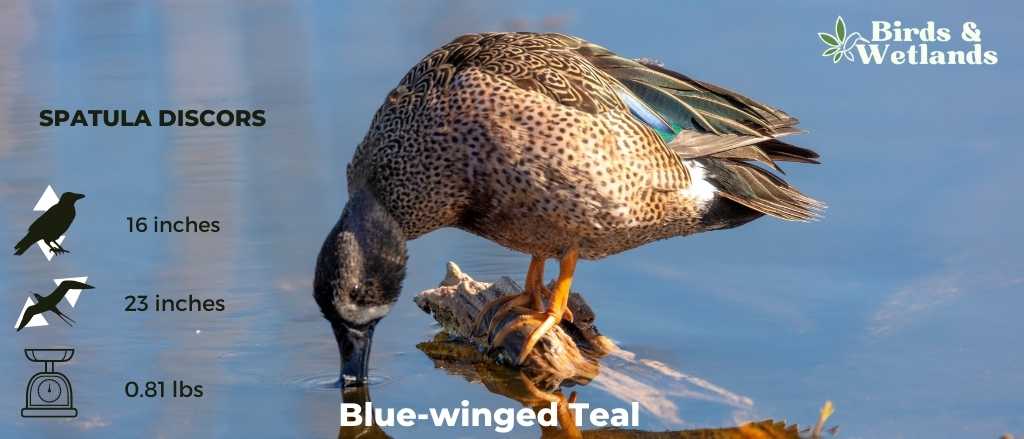

Listen to Blue-winged Teal
Scientific Name: Spatula discors
Length: 16 in
Wingspan: 23 in
Weight: 13 oz
The Blue-winged Teal is a small species of dabbling duck known for its striking plumage and its extensive migratory habits.
Appearance: Male Blue-winged Teals are quite colorful, with a slate gray head and neck, a white crescent in front of the eyes, and a predominantly brown body with specks of black. The name “Blue-winged” comes from the patch of blue feathers visible on their wings during flight. Females, in contrast, are primarily brown and subtly mottled to provide camouflage.
Diet: The Blue-winged Teal feeds mainly on plant matter, such as seeds and aquatic vegetation. However, they also supplement their diet with small invertebrates, especially during the breeding season. They are known for their “dabbling” behavior, where they feed at the surface of the water rather than diving.
Reproduction: Blue-winged Teals prefer to nest on the ground in grassy areas near water. The female typically lays a clutch of 9 to 13 eggs, which she incubates alone for about three weeks. After hatching, the ducklings can feed themselves but remain under the mother’s protection until they are capable of flying.
Northern Pintail

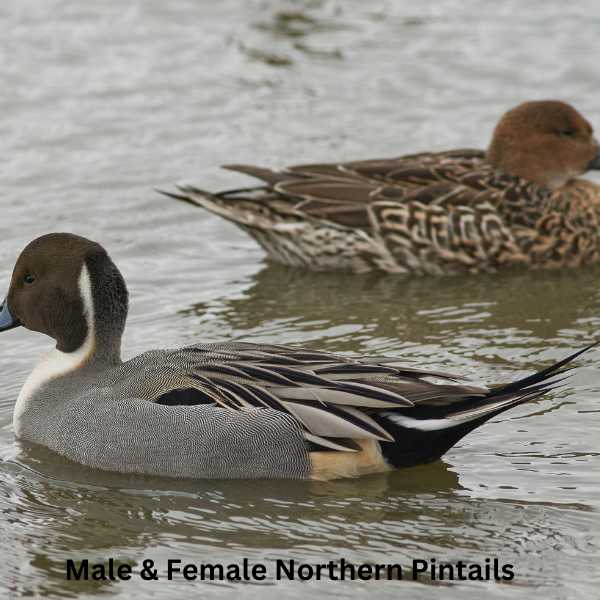
Listen to Northern Pintail
Scientific Name: Anas acuta
Length: 23–30 in
Wingspan: 31–37 in
Weight: 1 –3 lb
The Northern Pintail is a graceful species of duck recognized for their elegance in flight and their sleek bodies and long tails which is pin-shaped.
Male Northern Pintails are celebrated for their distinctive appearance, featuring a chocolate brown head, a white neck, and a grayish body. The most notable characteristic is the long, pointed tail feathers, which give this species its name. Females are more understated in color, sporting a mottled brown plumage.
Diet: Consists primarily of plant matter, including seeds and aquatic vegetation. They are also known to eat insects, especially during the breeding season. The Northern Pintail is often seen dabbling and upending in water bodies to forage for food.
Reproduction: Northern Pintails usually nest on the ground, near water bodies. The female lays a clutch of 7 to 9 eggs and is solely responsible for their incubation, which lasts for about three weeks.
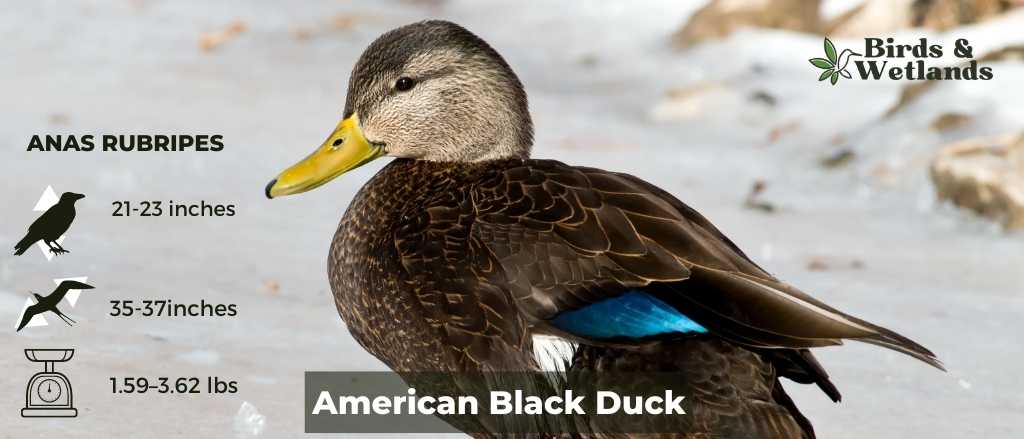

Listen
Scientific Name: Anas rubripes
Length: 21–23 in
Wingspan: 35–37 in
Weight: 1.59–3.62 lb
The Black Duck is a relatively large species of waterfowl known for its dark plumage and distinctive, richly flavored meat.
Appearance: Both male and female Black Ducks sport a similar look. They are predominantly dark brown in color with a lighter, beige-colored underbelly. They feature a yellowish-green bill, and their wings, when spread, reveal a purple-blue speculum bordered by two black bands.
Diet: Black Ducks primarily subsist on plant matter. They feed on seeds, leaves, and roots of aquatic plants, as well as grasses and crops. In addition, they sometimes eat small fish, insects, and aquatic invertebrates. These ducks can often be spotted foraging in shallow water bodies and marshlands.
Reproduction: Black Ducks typically create their nests on the ground, preferably in secluded, well-hidden spots near water bodies. The female usually lays a clutch of about 6 to 12 eggs, which she incubates for about four weeks.
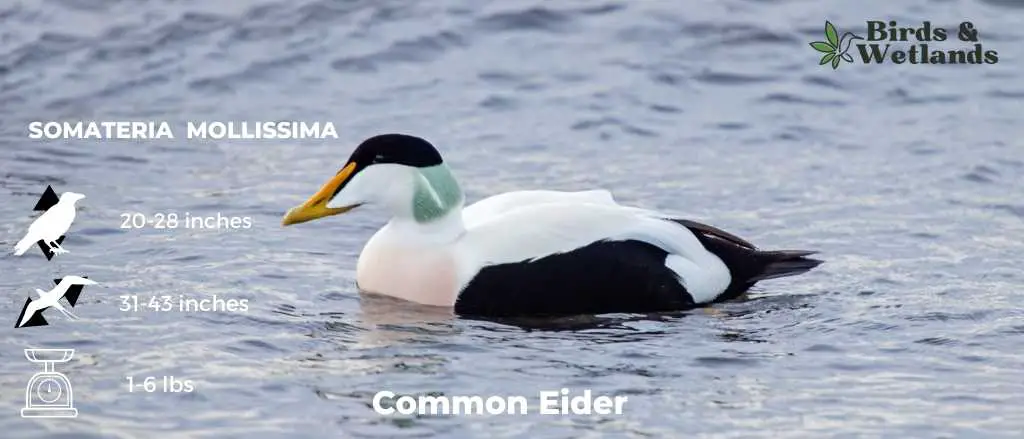

Listen
Scientific Name: Somateria mollissima
Length: 20–28 in
Wingspan: 31–43 in
Weight: 1 lb 12+1⁄2 oz to 6 lb 11 oz
The Common Eider is a large sea-duck, recognized for its striking appearance and the eiderdown it produces, which is harvested for insulation in high-quality bedding.
Appearance: Male Common Eiders have a distinctive look, with a black and white body, pale green nape, and a pinkish chest. Females, on the other hand, are mottled brown. Both sexes have a wedge-shaped bill and are known for their robust size.
Diet: The diet of Common Eiders mainly consists of marine animals. They frequently dive to feed on mussels, clams, and other shellfish. They also consume sea urchins, crabs, and occasionally, fish.
Reproduction: Common Eiders nest in colonies on islands or coastal areas, with nests often located close to vegetation for shelter. The female lays an average of 4 to 5 eggs and lines the nest with the famed eiderdown, plucked from her own chest. She incubates the eggs for approximately 25-30 days.
Bufflehead


Listen to Bufflehead
Scientific Name: Bucephala albeola
Length: 13–16 in
Wingspan: 21.6 in -23.2 in
Weight: 9.5–19.4 oz
The Bufflehead is a small, compact species of diving duck known for its striking appearance and large heads and unique nesting habits.
Appearance: Male Buffleheads are easily recognized by their large, bulbous head with a green-purple iridescent sheen, a large white patch across the back of the head, and a predominantly black and white body. Females are more subtly colored, primarily in gray-brown tones with a smaller white cheek patch.
Diet: As diving ducks, Buffleheads feed by diving beneath the water’s surface. Their diet consists largely of aquatic invertebrates, such as insects, crustaceans, and mollusks, as well as some plant matter.
Reproduction: Uniquely among ducks, Buffleheads often nest in tree cavities, especially those made by Northern Flickers, a type of woodpecker. The female lays a clutch of about 6 to 11 eggs, which she incubates alone for roughly a month.
Hooded Merganser

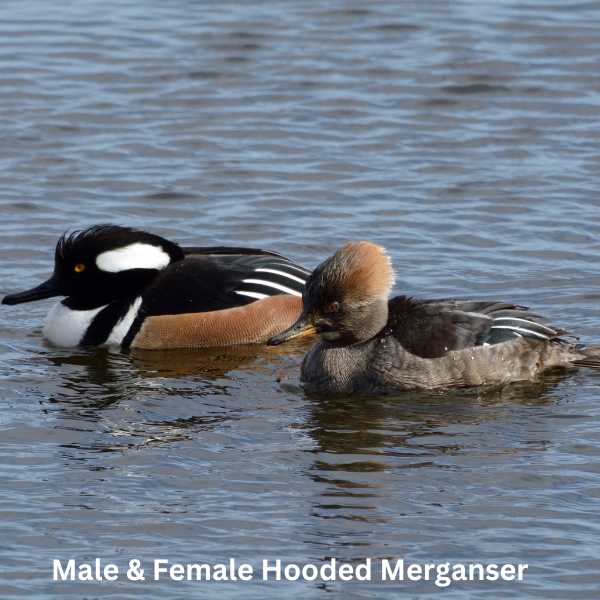
Listen to Hooded Merganser
Scientific Name: Lophodytes cucullatus
Length: 15.8-19.3 in
Wingspan: 23.6-26.0 in
Weight: 16.0-31.0 oz
The Hooded Merganser is a distinctive species of diving duck known for its showy crest and its excellent diving skills.
Appearance: Male Hooded Mergansers are especially striking with a large, fan-shaped, black and white crest, which can be expanded or contracted. They have bright yellow eyes, a dark back, and a white chest. The females have a more understated appearance with a brownish body, a smaller, reddish-brown crest, and dark eyes.
Diet: Consists of small fish, aquatic insects, and crustaceans. Their eyes are specially adapted for underwater vision, allowing them to spot and catch prey while diving.
Reproduction: Similar to Buffleheads, Hooded Mergansers often nest in tree cavities near water bodies. The female lays a clutch of about 10 to 12 eggs and incubates them alone for about a month.
Common Merganser

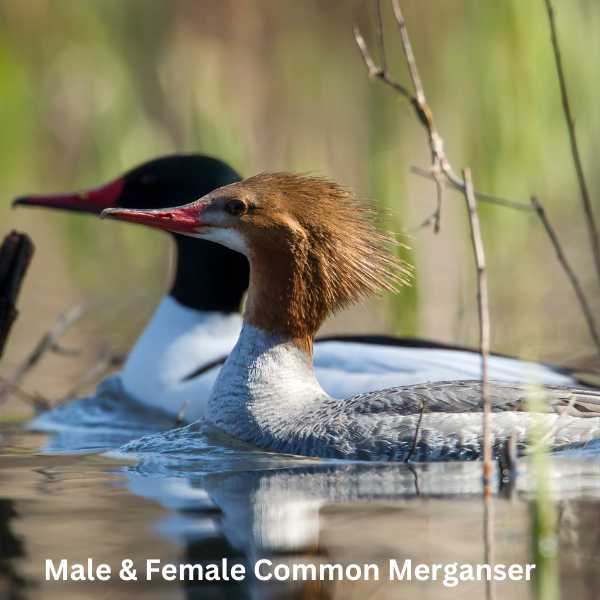
Listen:
Scientific Name: Mergus merganser
Length: 23–28 in
Wingspan: 30 – 38 in
Weight: 2 lb 0 oz – 4 lb 10 oz
The Common Merganser is a large and elegant diving duck, famous for its unique fishing abilities and seen often in the lakes, rivers, and coastal areas across North America.
Appearance: The male Common Merganser is quite striking with its dark green, almost black, crested head, bright red bill, and white body tinged with salmon-pink. The females have a reddish-brown crested head, a white neck, and a grayish body, but share the same red bill as the males.
Diet: True to their diving duck status, Common Mergansers are exceptional hunters, primarily feeding on fish. They’re also known to consume aquatic invertebrates and, on occasion, small mammals and birds. Their serrated bills are specialized to hold slippery fish tightly.
Reproduction: Like the Wood Duck, Common Mergansers also nest in tree cavities or nest boxes close to water bodies, but can also use rock crevices or holes in the ground. A clutch usually contains 9 to 12 eggs, incubated solely by the female.
American Coot

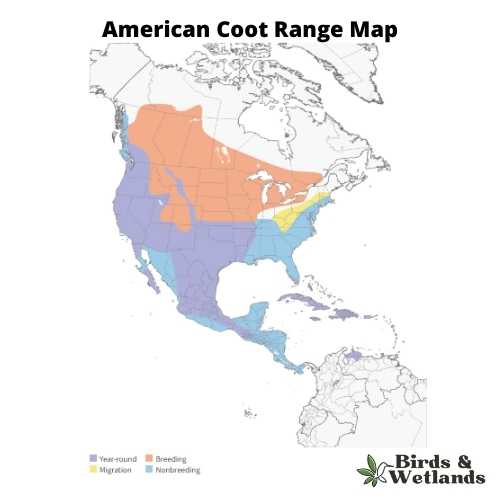
Listen:
Scientific Name: Fulica americana
Length: 13–17 in
Wingspan: 23 to 28 in
Weight: 1.270 to 1.870 lb
The American Coot is a ubiquitous water bird commonly seen in the wetlands, lakes, and ponds of North America, recognized for its adaptability and striking features.
Appearance: American Coots are easily identifiable by their slate-gray bodies, offset by a white, chicken-like bill and a red eye. Their legs are also distinctive, equipped with lobed toes, as opposed to the webbed feet seen in ducks, which assist them in navigating both land and water adeptly.
Diet: While aquatic plants form the bulk of an American Coot’s diet, they aren’t strictly herbivores. These versatile birds also consume small invertebrates and fish, demonstrating their ability to adapt and survive in a variety of habitats.
Reproduction: Nesting for the American Coot usually happens in shallow water bodies, where they construct a floating nest hidden among the vegetation. A clutch can contain between 8 to 12 eggs, all of which are incubated by both parents.
Sandhill Crane


Listen:
Scientific Name: Antigone canadensis
Length: 2 ft 7-4 ft 6 in
Wingspan: 16.5–23.6 in
Weight: 4 – 4.5 kg
The Sandhill Crane is a tall, elegant bird known for its impressive size and striking appearance. They are found across North America, in habitats ranging from wetlands to grasslands.
Appearance: Sandhill Cranes are recognized for their tall stature, gray body, long legs, and long neck. Their most distinctive feature is a red forehead, which contrasts with their otherwise primarily gray plumage. During the breeding season, their gray feathers often take on a rusty-brown hue due to them rubbing iron-rich mud onto their feathers.
Diet: Sandhill Cranes are omnivorous birds and their diet is quite diverse, consisting of seeds, grains, berries, insects, small mammals, reptiles, and amphibians. They are known to forage while walking in shallow water or in fields.
Reproduction: Sandhill Cranes mate for life and their complex courtship dance is a sight to behold. They nest in marshy areas and the female typically lays two eggs.
American Wigeon
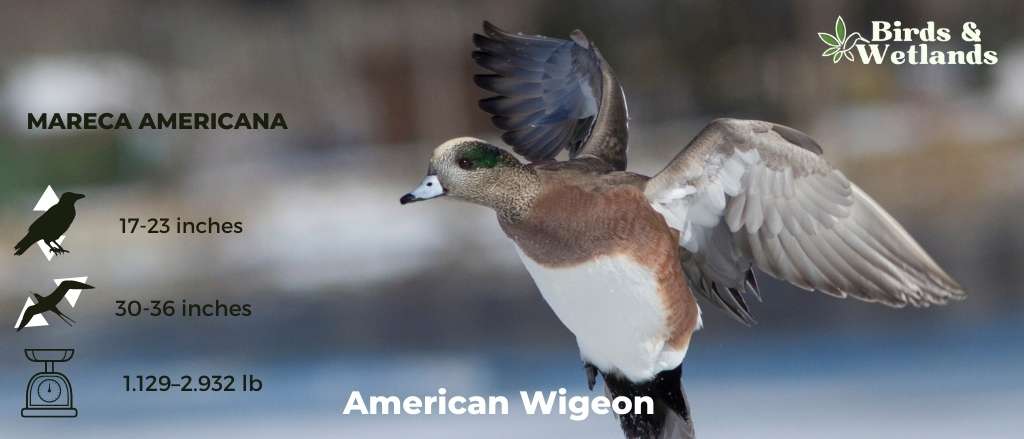
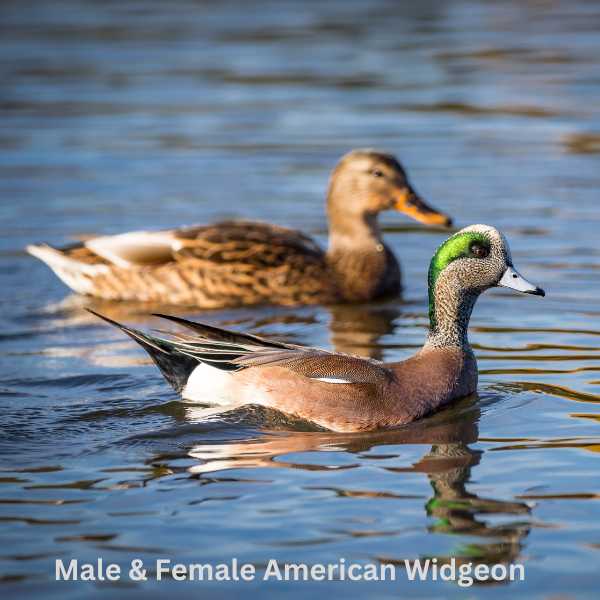
Listen to American Wigeon
Scientific Name: Mareca americana
Length: 17–23 in
Wingspan: 30–36 in
Weight: 1 –3 lb
The American Wigeon is a medium-sized duck species that is a popular sight in wetlands, ponds, and lakes and is often seen in mixed flocks with other ducks.
Males of the species are recognized by their distinctive appearance. They sport a unique white forehead and crown, coupled with a green band stretching from the eye to the back of the head. The body is mainly gray with a pinkish hue on the chest. Females are more subdued in color, with primarily gray and brown tones.
Diet: comprising mainly plant material like aquatic vegetation and grasses, but it also includes insects and other small invertebrates. They are known for a feeding behavior called “kleptoparasitism,” where they often snatch food from other ducks.
American Wigeons usually breed in the northernmost parts of North America. The females create their nests on the ground, often hidden in tall grass near water bodies. They lay a clutch of 6 to 11 eggs which they incubate for about three to four weeks and the ducklings feed on small aquatic invertebrates and aquatic insects.
Osprey (Pandion haliaetus)

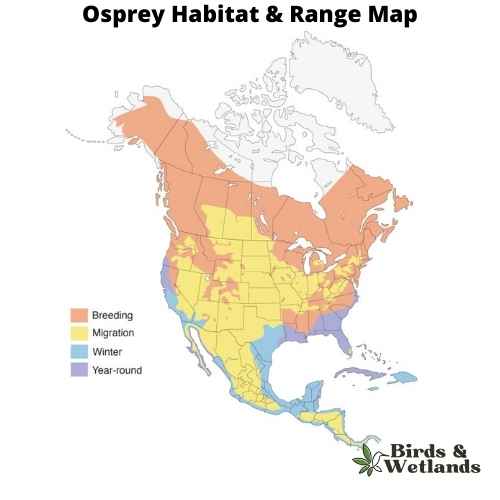
Osprey Sound
Scientific Name: Pandion haliaetus
Length: 50–66 cm (19+1⁄2–26 in)
Wingspan: 127–180 cm (50–71 in)
Weight: 0.9–2.1 kg (2 lb 0 oz – 4 lb 10 oz)
The Osprey, a fascinating bird of prey, is universally known for its exceptional hunting prowess and striking physical characteristics. Osprey are dark brown hawks on the upperparts, contrasting beautifully with the predominantly white underparts, and a distinctive dark band that stretches across the eyes towards the sides of its head.
Equipped with specialized talons and a reversible outer toe, the Osprey’s hunting strategy involves a spectacular plunge-dive into bodies of water, often emerging with a fish securely gripped in its claws.
Found on every continent except Antarctica, the Osprey is a cosmopolitan species favoring habitats near water bodies such as lakes, rivers, and coastal areas, reflecting its piscivorous diet. This bird has a diet almost exclusively of fish, making it a unique member of the raptor family and often referred to as the sea hawk or fish hawk. They locate their prey from the air, often hovering before plunging feet-first to capture a fish. When it comes to breeding, Ospreys are monogamous, often mating for life.
They construct large, bulky nests made of sticks, lined with softer materials, and prefer elevated or isolated areas such as treetops or artificial structures like utility poles. Both parents share the responsibility of incubating the eggs and rearing the chicks.
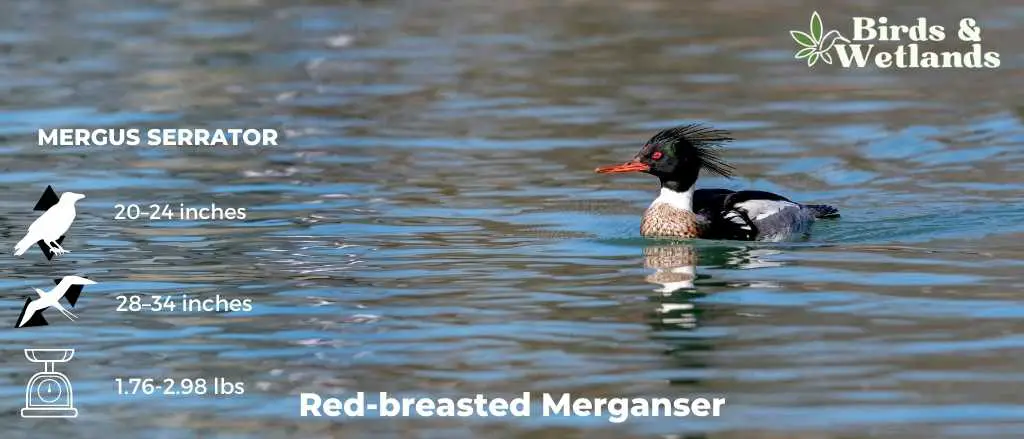

Listen
Scientific Name: Mergus serrator
Length: 20–24 in
Wingspan: 28–34 in
Weight: 28.2 to 47.6 oz
The Red-breasted Merganser is a fascinating diving duck species, recognized for its swift flight and exceptional diving capabilities. They inhabit freshwater and saltwater environments and are quite common in North America and Eurasia.
Appearance: The Red-breasted Merganser boasts an interesting appearance. Males display a dark green head, bright red eyes, and a distinctive, long reddish-brown breast. Their bodies are mainly grey, and they also have a white collar and a thin, serrated bill. Females are more subdued, featuring a rusty cinnamon head with a shaggy crest and grey body.
Diet: Predominantly includes small fish, which they catch by diving underwater. They can also feed on aquatic insects, crustaceans, and occasionally amphibians. Their serrated bill helps them grip slippery prey effectively.
Reproduction: The breeding ground for Red-breasted Mergansers is typically near freshwater lakes or rivers. Females build nests in tree cavities, on the ground hidden in vegetation, or use abandoned nests of other birds. The female lays a clutch of 6 to 12 eggs.
Common Loon

Listen:
Scientific Name: Gavia immer
Length: 24-39 in
Wingspan: 50-56 in
Weight: 6.4-13.6 lbs
The Common Loon is a large, iconic water bird that can be found in many parts of North America. It is known for its haunting calls, often heard in the early morning or late evening across the region’s lakes and ponds.
Appearance: The Common Loon is celebrated for its striking black-and-white breeding plumage, a red eye, and a robust, black bill. In winter, its plumage turns to a more subdued gray, but its large, sturdy body and pointed bill remain distinctive.
Diet: Common Loons primarily feed on fish, but also consume crustaceans, frogs, and aquatic insects. They are expert divers, capable of plunging deep underwater to catch their prey, and are often observed popping their heads above water before diving for their next meal.
Reproduction: The Common Loon nests near water, typically on lakes and larger ponds in the northern parts of North America. The female generally lays 1-2 eggs per year in a nest made from vegetation on the ground. Both parents share the responsibility of incubating the eggs and feeding the young.
Atlantic Puffin
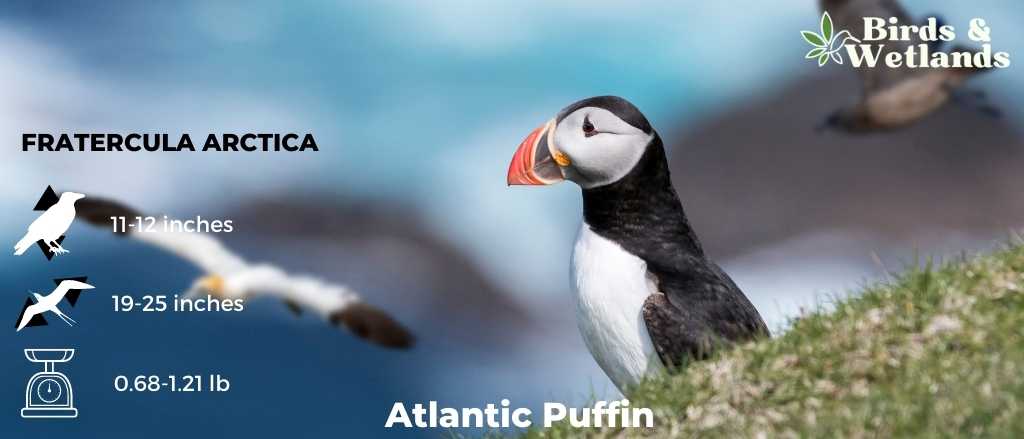

Listen:
Scientific Name: Fratercula arctica
Length: 11 to 12 in
Wingspan: 19 to 25 in
Weight: 10.9-19.4 oz
The Atlantic Puffin is a small seabird celebrated for its vibrant beak and its adeptness at diving and swimming.
Appearance: Atlantic Puffins have a unique appearance, characterized by a black back and white underparts. The most striking feature is their large beak, which is brightly colored in red, blue, and yellow during the breeding season but fades to a duller color in winter. Their faces are also predominantly white with a hint of gray.
Diet: The diet of Atlantic Puffins is composed mostly of small fish. They are expert divers and swimmers, often diving up to 60 meters to catch their prey, which includes herring, capelin, and sand eels.
Reproduction: Atlantic Puffins are colonial birds, nesting in large groups on coastal cliffs or offshore islands. They typically lay a single egg per year in a burrow dug into the soil or in a crevice among the rocks. Both parents share the responsibility of incubating the egg for about 6 weeks and feeding the chick until it’s ready to fledge.
The Least Bittern (Ixobrychus exilis)
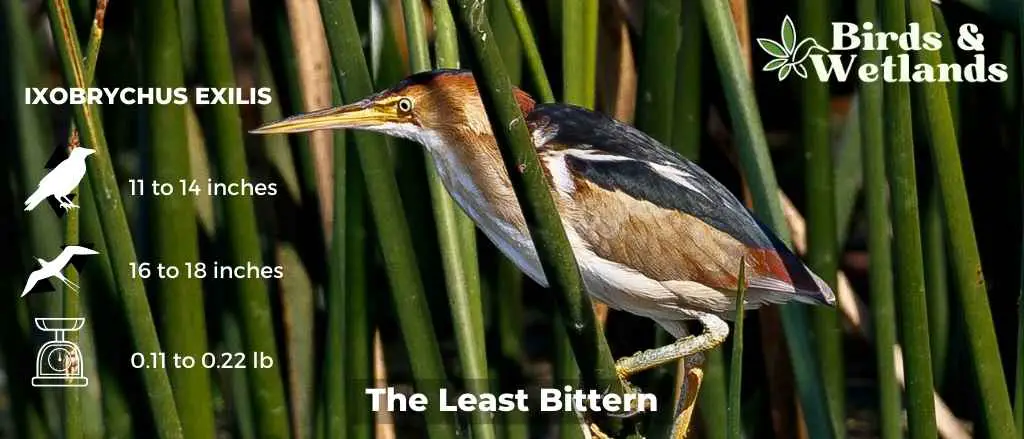

Listen
Scientific Name: Ixobrychus exilis
Length: 11 to 14 in
Wingspan: 16 to 18 in
Weight: 1.8 to 3.6 oz
The Least Bittern is a small and secretive water bird species that often goes unnoticed in its marshy habitat due to its cryptic behaviors and coloring.
Appearance: The Least Bittern is a compact bird with a hunched posture and short neck. It features a mix of buffy and brown coloration on its upper parts, while its chest and neck are more of a pale, buffy color. The males have darker backs and caps than the females. A distinctive feature of this bird is its yellow eyes.
Diet: The Least Bittern’s diet consists mainly of small fish and invertebrates. They forage by stalking slowly through their marshy habitat and striking out with a swift jab of their bill to snatch their prey.
Reproduction: Least Bitterns are solitary nesters, often hiding their nests in dense wetland vegetation. The female lays between 4 to 7 eggs and both parents participate in incubation and feeding.
Where To Spot Maine’s Water Birds
Aside from all along the Maine coast (especially great for spotting sea ducks) the following places are great for spotting wading birds and other water birds:
Acadia National Park, Mount Desert Island: Nestled on the coast, this national park provides a home for a variety of water birds, including the Common Loon, various ducks, and the American Black Duck, the green winged teal and the female and male wood duck.
Rachel Carson National Wildlife Refuge, York County: Covering 50 miles of coastline, this refuge is a haven for water birds, including the American Bittern, the Least Bittern, and the Green Heron.
Moosehorn National Wildlife Refuge, Baring and Edmunds: As one of the northernmost National Wildlife Refuges, it offers sightings of the Common Goldeneye, the Hooded Merganser, and other species in its marshes, streams, and ponds.
Sunkhaze Meadows National Wildlife Refuge, Penobscot County: With a mix of wetland habitats, it is an ideal location to see species such as the American Black Duck, the Ring-necked Duck, and the Canada Goose.
Eastern Egg Rock, Muscongus Bay: Home to the Project Puffin restoration project, this tiny island attracts Atlantic Puffins, Common Terns, and Roseate Terns during breeding season.
Other spots include Machias Seal Island, you’ll commonly encounter on Machias Seal Island include species like puffins, razorbills, and terns, which have adaptations more suited to a life spent in or near the sea. Unlike ducks, these seabirds are equipped to dive deep into the water to catch their prey.
The Fish and Wildlife Service in Southern Maine advises against feeding Canada Geese for several reasons.
First, providing food can lead to an artificial increase in the population of these geese, which can cause overgrazing and degrade natural habitats. This can disrupt the balance of local ecosystems and have negative impacts on other wildlife.
Second, feeding can result in the geese becoming habituated to humans. This can lead to them becoming aggressive or causing nuisances in public spaces such as parks or residential areas.
| Neighboring State | Best Spots for Birdwatching |
|---|---|
| New Hampshire Water Birds | Great Bay National Wildlife Refuge, Lake Umbagog National Wildlife Refuge, Hampton Beach State Park |
| Vermont Water Birds | Missisquoi National Wildlife Refuge, Dead Creek Wildlife Management Area, Lake Champlain |

